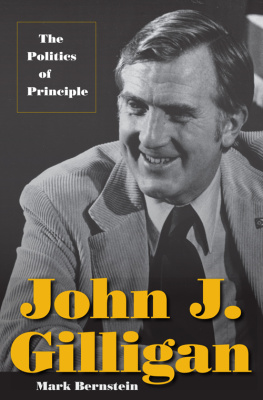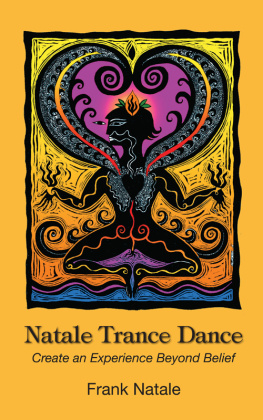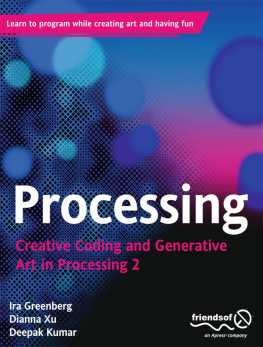Stephen Gilligan - Generative Trance: The experience of Creative Flow
Here you can read online Stephen Gilligan - Generative Trance: The experience of Creative Flow full text of the book (entire story) in english for free. Download pdf and epub, get meaning, cover and reviews about this ebook. year: 2012, publisher: Crown House Publishing, genre: Science. Description of the work, (preface) as well as reviews are available. Best literature library LitArk.com created for fans of good reading and offers a wide selection of genres:
Romance novel
Science fiction
Adventure
Detective
Science
History
Home and family
Prose
Art
Politics
Computer
Non-fiction
Religion
Business
Children
Humor
Choose a favorite category and find really read worthwhile books. Enjoy immersion in the world of imagination, feel the emotions of the characters or learn something new for yourself, make an fascinating discovery.
- Book:Generative Trance: The experience of Creative Flow
- Author:
- Publisher:Crown House Publishing
- Genre:
- Year:2012
- Rating:3 / 5
- Favourites:Add to favourites
- Your mark:
- 60
- 1
- 2
- 3
- 4
- 5
Generative Trance: The experience of Creative Flow: summary, description and annotation
We offer to read an annotation, description, summary or preface (depends on what the author of the book "Generative Trance: The experience of Creative Flow" wrote himself). If you haven't found the necessary information about the book — write in the comments, we will try to find it.
Generative Trance: The experience of Creative Flow — read online for free the complete book (whole text) full work
Below is the text of the book, divided by pages. System saving the place of the last page read, allows you to conveniently read the book "Generative Trance: The experience of Creative Flow" online for free, without having to search again every time where you left off. Put a bookmark, and you can go to the page where you finished reading at any time.
Font size:
Interval:
Bookmark:
This major new work from renowned author and trainer Stephen Gilligan reveals how life can be lived as a great journey of consciousness. The author emphasizes that reality and identity are constructed by ourselves, and explains how generative trance is crucial in creating new realities and possibilities for clients. It is a view that differs markedly from the traditional hypnosis ideas of a client losing control, as well as from Ericksonian approaches that feature a benevolent hypnotist who bypasses the conscious mind to work with a clients unconscious mind. Instead, generative trance stresses a disciplined flow process in which a persons conscious and unconscious minds cooperate to weave a higher consciousness capable of transformational change.
The book offers a framework for developing this creative consciousness, including step by step processes for creating it. Stephen Gilligan has been developing this work over the past thirty five years, first as a protg of the great hypnotherapist Milton Erickson, and then as the originator of the post-Ericksonian approaches of Self-Relations and Generative Self.
William James used to say that the unconscious mind is the horse and conscious mind is the rider: its the relationship between the two that is most important. This book shows you how to harness the relationship for a much more powerful and effective therapeutic intervention.
Generative Trance: The Experience of Creative Flow, Stephen Gilligans newest book, is not only exciting to read, it gives new ways of looking at already-known information and adds whole new dimensions of different perspectives. Firmly built on his mentoring by Milton Erickson, Gilligan did what Erickson urged all his students to do - he took ideas from Erikson and made them applicable to new and different circumstances.
Beginning with understandable definitions, Gilligan lays out his own framework. The reader is captured with new ideas for hypnosis an up-dating, so to speak, of what hypnosis is. Generative trance is the real communication. It is not a place where the therapist provides answers and techniques for change, but where the client can have experiential learning, a reconfiguration of his own unconscious or forgotten resources. This, as evidenced by Ericksons work, is how lasting and sometimes remarkable and quick changes are achieved.
Under this umbrella of generative trance, he breaks his ideas into separate pieces. He discusses the familiar situation of a client frozen and seemingly unable to act, explaining how this is part of what he refers to as neuromuscular lock and literally takes apart what is happening. Then he provides clear methods of using generative trance, how client resources can be accessed and how different, more productive responses, can be learned and practiced. His approach is convincing, intriguing and eminently do-able.
His idea of centering is inclusive of what most people understand this term to mean. But typical of all of his writing, he uses words so precisely and carefully, that the reader stops to absorb his more expansive definition fully. Some of his phrases are immediately transferable to any therapeutic session you (can) feel both a part of and apart from an experience be with something without becoming it . He points out that when people learn to be centered, they can be vulnerable . Then with generative trance states, they can provide new and safe places within themselves and new learning and the transformation of dysfunctions can occur more easily.
Gilligan believes, as Erickson did, that peoples realities and fixed meanings have to be broadened. A change in perspective allows people to respond differently; each person can create a different sense of self a different identity as all of us have done since childhood. Generative trance allows this easily and naturally.
He goes into detail with some of the ideas for example, Creative Acceptance which redefines acceptance not as passivity but as an active curiosity about what something might be if it were accepted. This counter-intuitive idea accept something to change it is detailed in one of Ericksons cases the girl with the gap between her two front teeth. Gilligan connects this to the first part of his book seamlessly.
Part of the book holds case examples in script form. This clarifies and demonstrates the uses of generative trance states. He gives explanations of what he was doing and even little, easy-for-all to do ideas, such as various phrases to insert in any hypnotic work trance is a learning place and the words Erickson used so often, trust your unconscious. Each script is primarily aimed at one of the points Gilligan has made earlier in the book, and the how and why is explained. Additionally, as he points out, shorter versions of the scripts are useful to all in everyday life we all need to be able to become more centered, to be in touch with our bodies and relax comfortably while maintaining alertness.
One of the bonuses always present in Gilligans writing is his use of meaningful, often beautifully poetic, quotations from a huge variety of sources to begin every chapter. And its in this book too.
Generative Trance is an extraordinary book filled with different and new perspectives , captivating, and most important valuable. My father would be so proud!
Betty Alice Erickson, M.S.
Steve Gilligan is the closest Ive experienced to being with Milton Erickson since Ericksons death in 1980. His new book, Generative Trance, delivers a tour- de-force of the latest thinking of third-generation hypnosis in a charming and organized way. This is the definitive overview of a new approach in psychotherapy and change work. I continue to learn from Gilligan and look forward to returning to this book, again and again, to gain even deeper insights.
Bill OHanlon, author of Taproots, An Uncommon Casebook, A Guide to Trance Land and Solution-Oriented Hypnosis
Steve Gilligan says we are on a journey a journey of infinite possibilities but only if we are open and aware. Generative Trance is not another cognitive change process. It is about using trance to learn how to love and access the wisdom of your deeper mind, so that new awareness and choice can emerge. Whether you read this exceptional book for your personal development, or you facilitate others in theirs, you will discover that Generative Trance leads to a kind of sacred sight, after which your world will never look quite the same again. What a journey!
Penny Tompkins and James Lawley, authors ofMetaphors in Mind: Transformation through Symbolic Modelling
There is a revolution taking place in psychotherapy that sheds the limitations of nave models of therapy and change. Stephen Gilligan is one of the most important leaders in this transformation of practice, particularly as it applies to hypnosis . His generative trance marks a major advance in helping us resourcefully relate to all that clients and therapists bring to a session. We enthusiastically recommend it to both your conscious and unconscious mind!
Bradford Keeney, Ph.D. & Hillary Keeney, Ph.D., authors, Circular Therapeutics: Giving Therapy a Healing Heart andA Master Class in the Art of Performing Change
This latest book by Steve Gilligan puts into practice the Ericksonian principles he has taught brilliantly for decades. He extends his self-relations model in several important ways, especially in the memorable sections on welcoming and weaving the identity parts into generative trance in order to allow new parts of the self to be born through generative transformation.
Though not a simple book, Generative Trance
Font size:
Interval:
Bookmark:
Similar books «Generative Trance: The experience of Creative Flow»
Look at similar books to Generative Trance: The experience of Creative Flow. We have selected literature similar in name and meaning in the hope of providing readers with more options to find new, interesting, not yet read works.
Discussion, reviews of the book Generative Trance: The experience of Creative Flow and just readers' own opinions. Leave your comments, write what you think about the work, its meaning or the main characters. Specify what exactly you liked and what you didn't like, and why you think so.












